Get More Customers Using Salesforce’s Pardot Marketing Automation Solutions
We recently held a power breakfast along with Salesforce focused on “Gaining Clients Using Marketing Automation in Professional Services.” During the event, we analyzed strategies for improving customer acquisition and management as well as the appropriate CRM and Marketing Automation tools to do so: Salesforce Sales Cloud and Pardot.
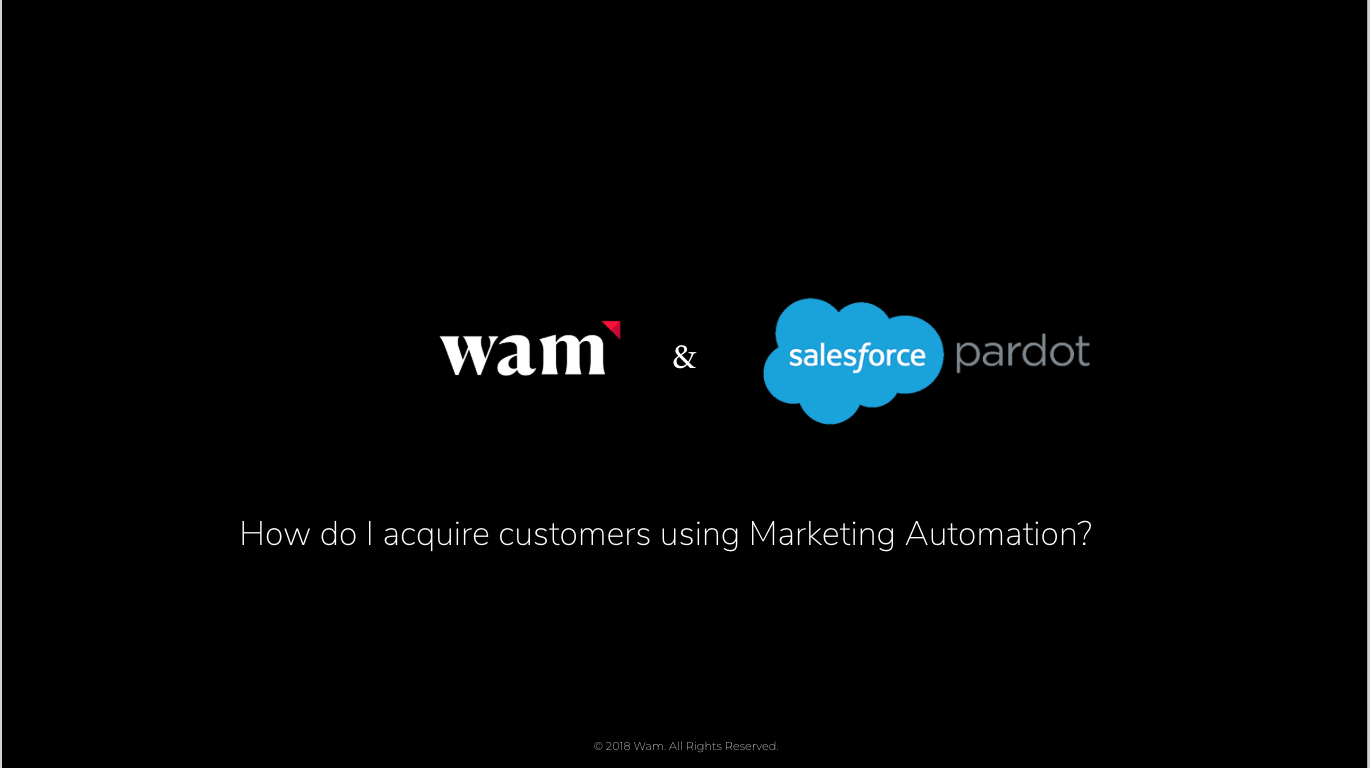
How can we acquire new customers using Marketing Automation?
How can we acquire customers using Marketing Automation tools? That was the question we were trying to answer during the event. To arrive at an answer, the most important thing is to understand that this process has two phases: the first is acquiring new leads or potential customers using digital and inbound marketing strategies. The second is converting these leads into opportunities and customers.
For each phase, we need to trace different strategies and use the tools most equipped for them:
- Acquiring leads/potential customers: for the first phase, we need a digital marketing strategy and Salesforce’s Pardot Marketing Automation tool.
- Converting leads into customers: here, we need to develop an appropriate alignment between Marketing and Sales and use Salesforce CRM (Sales Cloud).
It's important to clarify that, in acquiring new customers and increase sales, both phases are necessary. And besides that, the stages and the departments carrying them out have to be aligned in their objectives (Sales & Marketing Alignment).
Sales funnel: From lead to customer
The sales funnel is a highly frequently-used visual resource to understand the funnel that leads pass through to become customers.
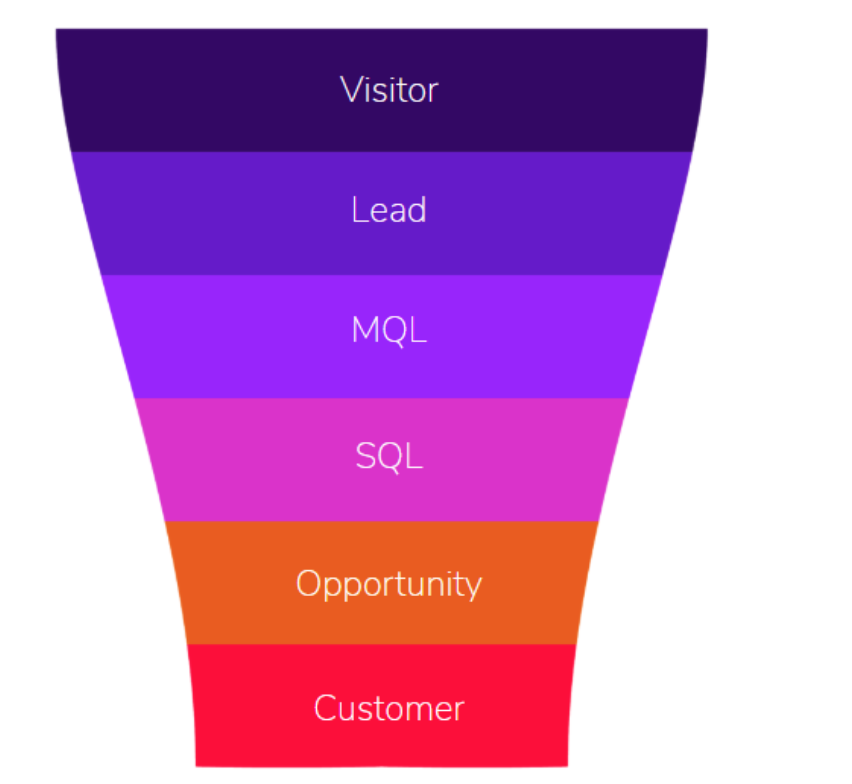
During the acquisition of new leads, they pass through the following phases of the funnel:
Strangers
To gain new clients in the digital space, Professional Services, and industry with a B2B focus, the first thing to do is to attract these potential clients to our website. To make that happen, we’ll use digital strategies like blogging, Search Engine Optimization (SEO), branding, social media, Google AdWords, mobile optimization, videos, infographics, influencer marketing campaigns, and so on that let us attract these strangers and turn them into visitors.
Visits
Pardot, our Marketing Automation tool, lets us get to know the behavior of the visits to our website: what pages or sections do they visit, how long do they spend on each of them, and more. A user's interest differs if they only read an article from one that afterward goes to the Services section and looks at the different service offerings.
Pardot lets us know about these interactions; but that information doesn’t suffice, given that it’s anonymous. We need to convince the stranger that they leave us their information and this resulting in us offering them a value-adding asset.
Let’s take a look at an example from the professional services industry:
A law firm is trying to capture leads interested in International Arbitration. After identifying keywords that our potential clients use to look for these services, we’ll have to generate relevant content. An example could be a blog post or article called Updates from the London International Court of Arbitration (LCIA).
Using Pardot, we'll be able to watch the positioning of these keywords and know, for each one, information about their positioning on GoogleRank, Bing Rank, the traffic volume on Google for a said keyword, the Google CPC as well as the Ranking Difficulty indicator.
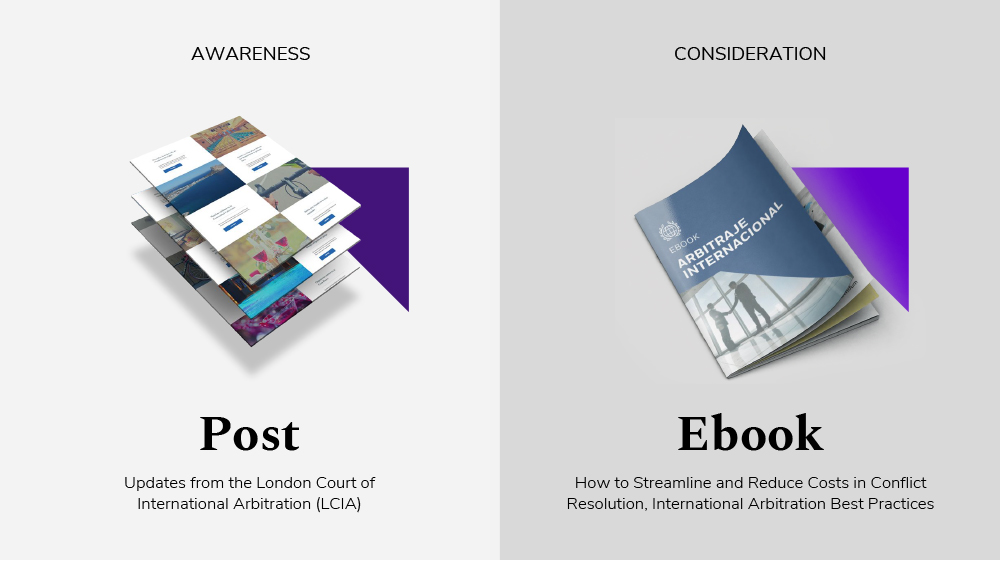
Once we have a visitor on our website, using CTAs (Calls to Action), offer the visitor a related asset so they will leave us their contact information and keep interaction with them. Continuing with the law firm example, we decide to offer an ebook that could be of interest. The title could be How to Streamline and Reduce Costs in Conflict Resolution, International Arbitration Best Practices.
Prospect
We come back to the funnel, and at the moment a visitor fills out one of the forms (integrated with Pardot) to request to download it. When we have this visitor identified, we then determine that we have a prospect.
But is this prospect qualified to get referred to the sales team? No, we need to conduct an automated qualification, and here we get to one of our Marketing Automation tool’s most fundamental functions that let us perform Lead Nurturing.
What is Lead Nurturing, you ask? It’s a technique based on establishing a series of automatic interactions with the user that vary based on the moment of the buyer journey that the leads find themselves in. To properly carry out lead nurturing, it’s necessary to establish a Lead Scoring and Lead Grading system. Again, Pardot is going to play a critical role in carrying out and automating this process.
Pardot Lead Scoring is in charge of qualifying a database’s leads based on their degree of interest in our services through their interactions with the website, their opening of emails, their downloads, and more. It will determine a grade in the Pardot scoring panel. This way, Scoring shows us the prospect’s engagement with our firm.
We can see the various interactions of a prospect and the value that’s assigned to each of them in the image below.
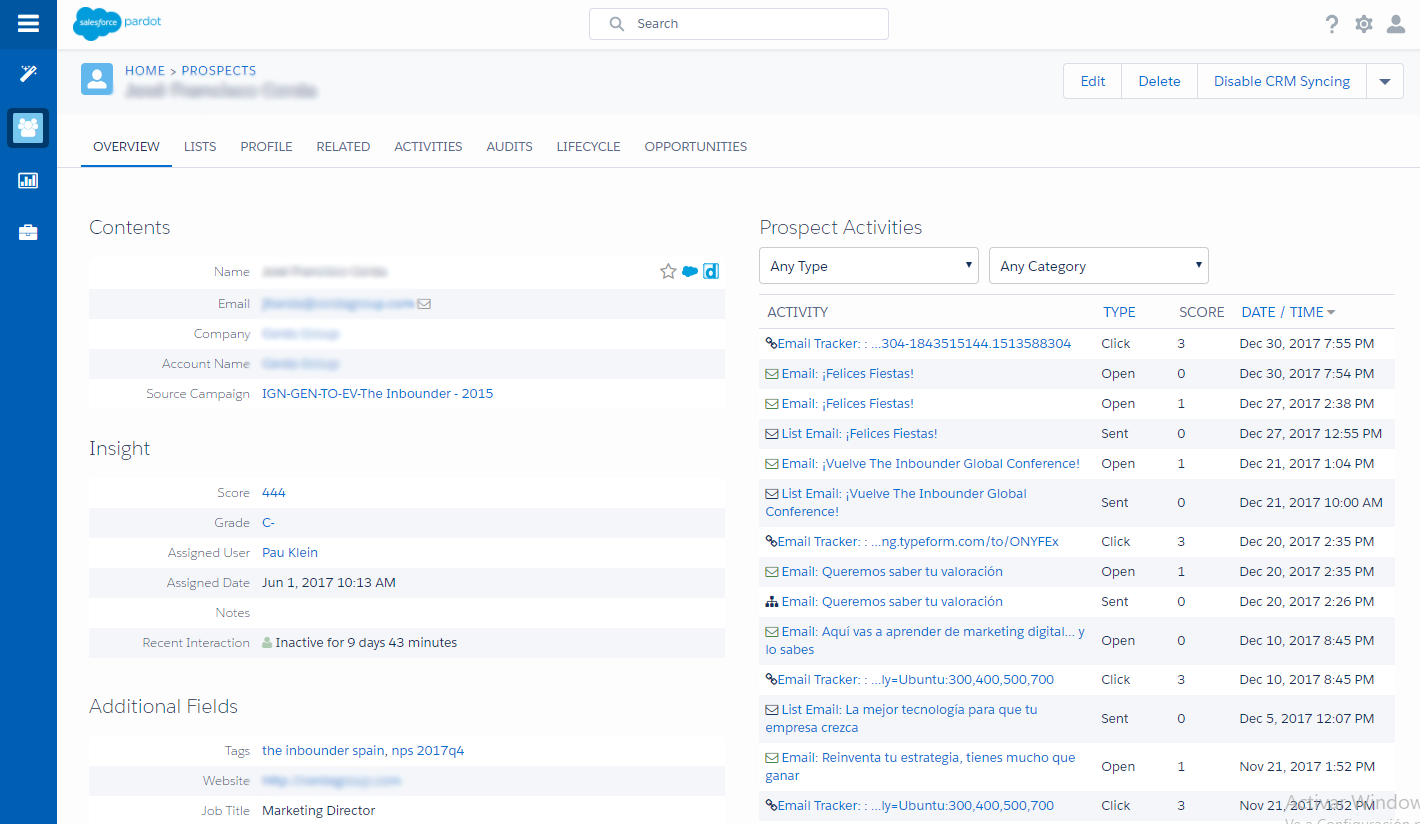
Pardot Lead Grading serves to gauge the interest the company has in that user. The grading is based on explicit information that we have about the lead (industry, title, company size, and more).
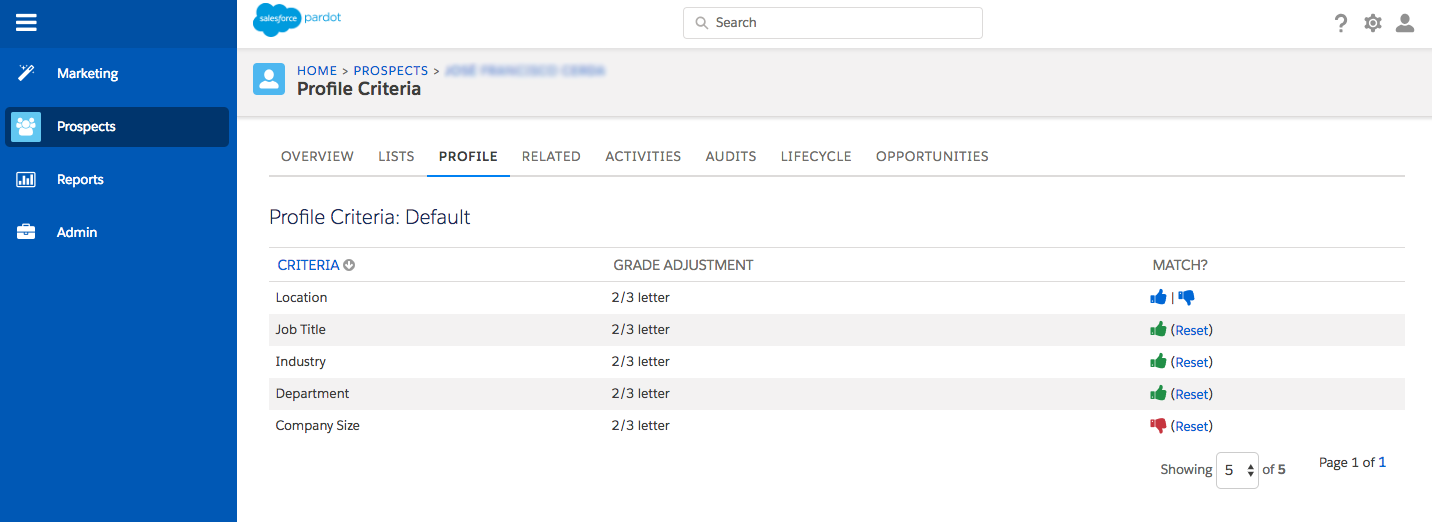 Therefore, the Scoring number indicates how interested or committed a prospect is to the company; the Grading score determines the degree of interest the company has with that prospect. We can use the Progressive tabs on Pardot forms that adapt to every user based on the information we already have available about them with every subsequent download and be able to compile more information to qualify them.
Therefore, the Scoring number indicates how interested or committed a prospect is to the company; the Grading score determines the degree of interest the company has with that prospect. We can use the Progressive tabs on Pardot forms that adapt to every user based on the information we already have available about them with every subsequent download and be able to compile more information to qualify them.
Workflows: actions, scoring, and automatic grading
Having a prospect’s email address is not enough to carry out an effective acquisition tactic; to do that, we need to be familiar with their interests and their willingness to be contacted. How do we get that? By creating workflows (using the Engagement Studio feature) where we'll offer different alternatives and will automate our reactions based on the prospect.
Based on how the user progresses with the workflows, the prospect will acquire different scores and grades. This way we'll be able to focus our attention and efforts on those that embody a behavior that our Marketing department defines as our ideal lead.
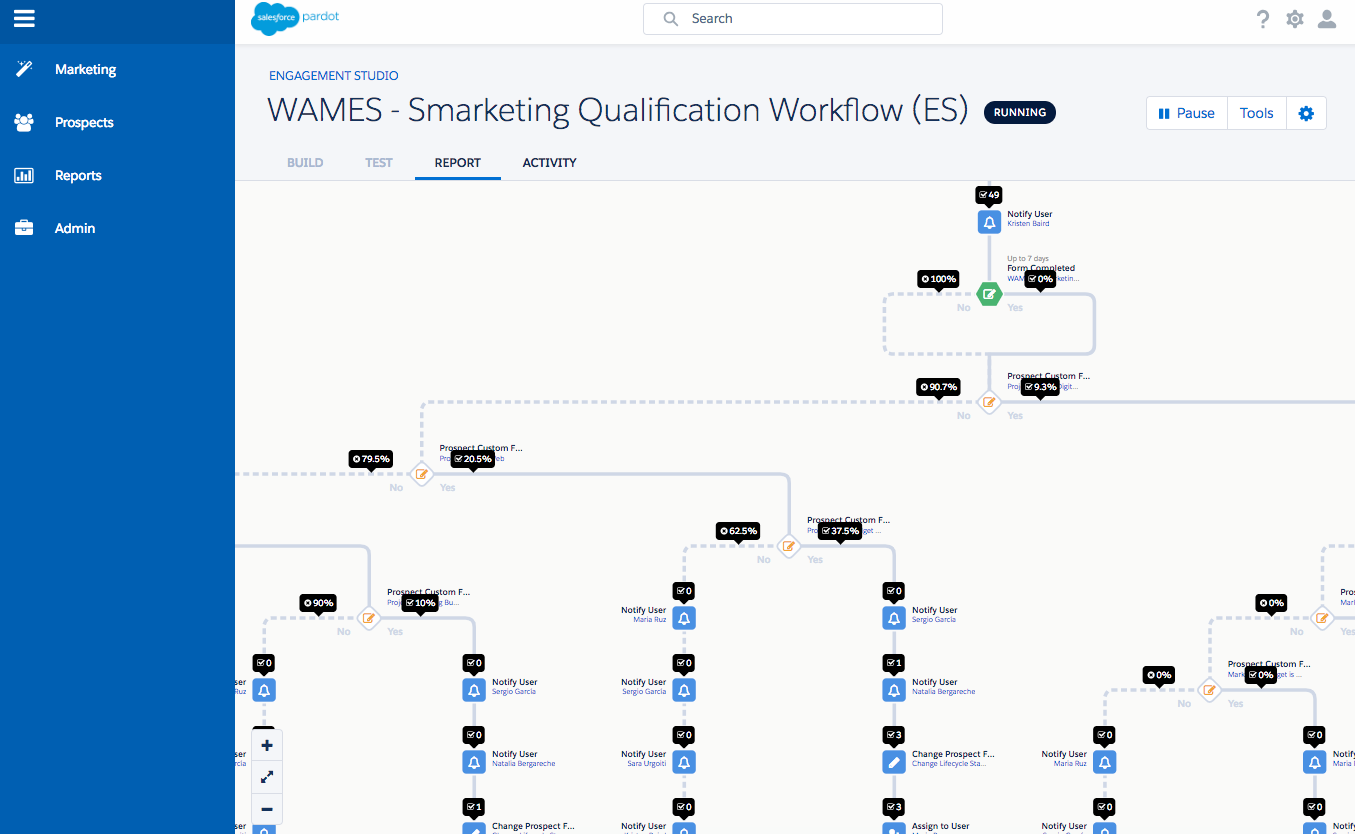
Pardot Engagement Studio: we can see the Engagement Studio function in the above graphic where we can see how the options branch off depending on the decisions or actions that a potential customer (lead) takes.
For example, if the lead opens emails, we can dictate that the system waits for four days before it makes its next contact; while if the lead does not open the email, we can send the lead a second email with a different subject two days later.
We plan and configure these “paths” only once, and we define what first event or action dictates them: it could be downloading an ebook, subscribing to the newsletter, or requesting more information. Based on the initial event and the information we have available that we’ll include in one workflow or another. This way, every lead will get the information relevant to their interests at the right time.
Continuing with the law firm example:
Once the prospect downloads the e-book, we’ll have their email address at our disposal. As this is not efficient, we can create a workflow that sends the prospect an email where they can download a new asset (e-book, webinar, among others). If the prospect opens the email and downloads the asset, an action occurs; if not, another action happens, and the cycle continues.
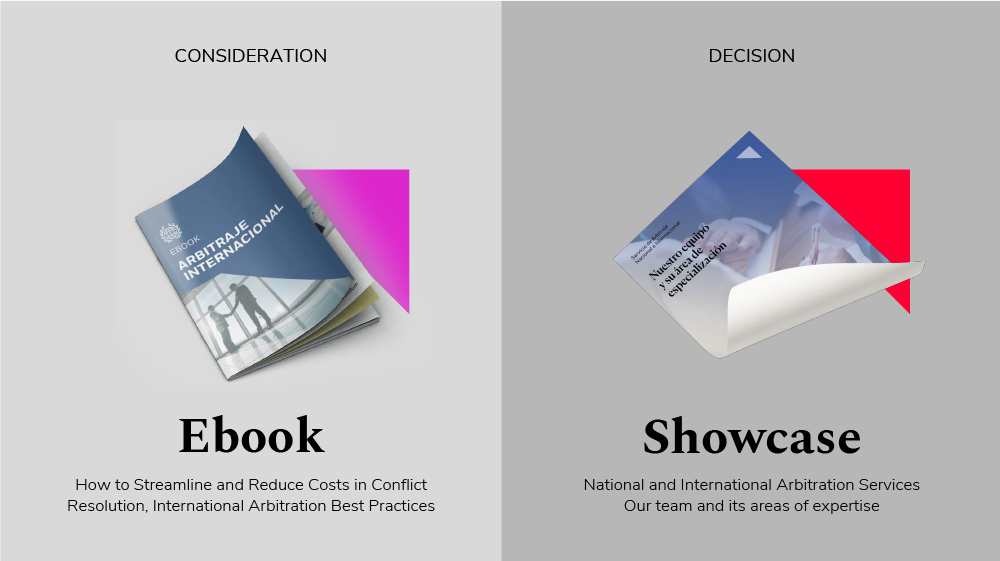
After downloading the e-book, we can offer the prospect a showcase about the law firm's Domestic and International Arbitration service. If the prospect acts, their scoring will automatically increase. In the case of not demonstrating interest, we'll be able to offer the prospect information about other areas or services that the firm provides to try to determine what their areas of interest are.
From Prospect to MQL
Once a prospect reaches a determined scoring value (that the prospect is interested in our services) and grade (their profile is of interest to the firm) we can automatically assign the prospect to the person with expertise in the area of interest. Pardot lets us automatically do this.
With Pardot Automation Rule, we can create an automated rule that converts a prospect into an MQL (Marketing Qualified Lead) and assign the prospect to a Salesforce CRM user.
Continuing with the example of the law firm offering international arbitration services, we can rule that users that have reached 200 points and have visited our firm’s arbitration page at least twice, we will automatically assign this visitor as a lead in Salesforce CRM to our partner specialized in international arbitration.

Salesforce CRM (Sales Cloud): critical to the sale
In Professional Services, personal contact is critical for acquiring a new customer. To do so, once we’ve identified a potential customer using Marketing Automatic, we’ll need to assign the lead to one of the Salesforce CRM users, so they can perform a personalized interaction and acquire the new customer. All the information gathered in Pardot, like the number of downloads, pages the lead has visited, the services where the user has demonstrated interest, and more, will be available for a salesperson.
Acquiring new clients requires effort and personal commercial/professional attention. Nonetheless, thanks to tools like Pardot we’ll be able to increase the efficacy of these actions.
Going back to the article example, if we sent the head of the Domestic Arbitration practice all the visitors that read the published blog post, say, 300 people, we would only end up overwhelming that person and would stop paying attention to those leads after a few days.
Nonetheless, if we're able to identify the prospects that are our real target and are in the right part of the buyer journey, our acquisition tactics' efficacy will be much better, and we'll see an increase in our new customer conversions.
The takeaway from all of this is as follows: our website can have tens of thousands of visitors a month, and each one will be in a different stage in the customer journey. Thanks to marketing automation, we’ll be able to identify the needs of each of them, performing lead nurturing, and pinpoint the right moment to contact them.
Contacting the right lead at the right time is one of the keys to acquiring more customers.
Are you already thinking about starting to implement your Marketing Automation strategy?
Subscribe to our newsletter and stay up to date with the latest digital trends.
Subscribe to our newsletter and stay up to date with the latest digital trends.
No thanks. My inbox is fine as it is.